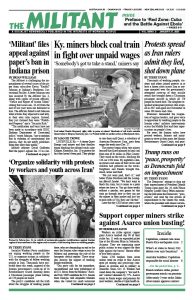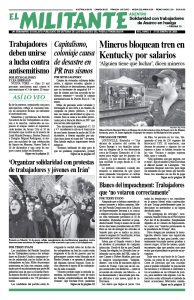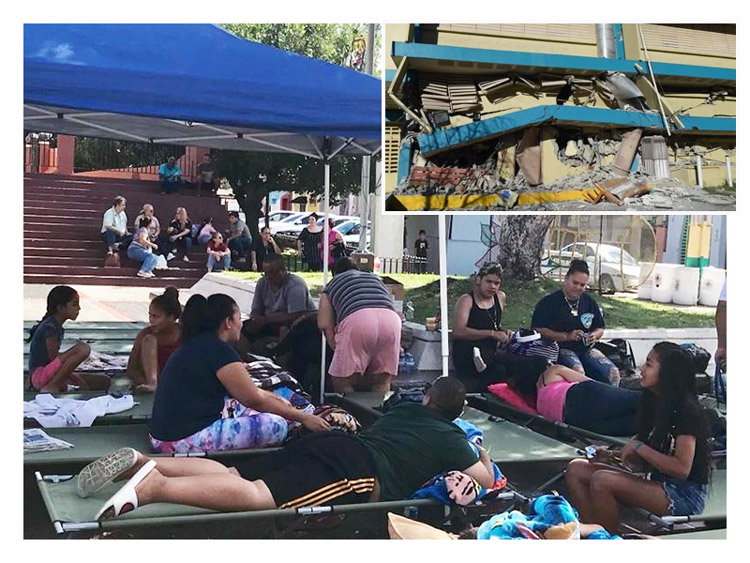Hundreds of homes suffered serious damage, along with some schools, churches and other buildings that collapsed, after a 6.4 magnitude earthquake — one of hundreds over the last several weeks — rocked the southern part of the U.S. colony of Puerto Rico Jan. 7.
Thousands are living and sleeping outdoors or in makeshift tent cities in public plazas, and thousands more are without electricity and running water. This comes on top of still unrepaired damage from Hurricane Maria in 2017.
Three earthquakes of 4.7, 5.0 and 4.7 magnitude shook the island within three hours overnight Dec. 28, followed by many others until the most powerful quake Jan. 7. Significant aftershocks continue.
Gov. Wanda Vázquez tried to sidestep any government responsibility for the unfolding social crisis. “We are talking about something for which we could not prepare, [un]like hurricanes, which we can see,” she told the press.
But it’s never been a secret that major faults run underneath Puerto Rico. Neither the U.S. colonial masters nor its local underlings adopted any construction standards for earthquake risks until 1987. Under pressure the Puerto Rican government tightened those regulations in February 2019, requiring new buildings to be able to withstand a 6.5 quake, but it never required retrofitting, even for schools or hospitals. And it did nothing to ensure that adequate food, water or medical care was in place for when a quake did hit.
For more than a decade and a half, instead of modernizing infrastructure, the U.S. government and the colonial regime on the island have cut social spending, slashing pensions, spending on health care and schools, and cut back on maintenance of the electric grid. Squeezing working people to pay billions in interest on debt built up mostly to U.S.-based bondholders has been the government’s highest priority. And then President Barack Obama set up the Financial Oversight and Management Board for Puerto Rico — still running today — to make sure the payments continue and that the government defends the interests of capitalist investors and bankers.
A catastrophe caused by capitalism
All this just helps show that the social crisis is not the result of a “natural disaster.” It’s the product of colonial rule and capitalist exploitation and the U.S. and local capitalist class’s disdain for working people.
And just like after the 2017 hurricane, working people, community groups and churches have taken the lead in providing food and shelter for those in need, in the face of inaction by the U.S. and Puerto Rican governments.
“Everybody is sleeping on the street because we don’t know when the aftershocks are going to stop,” artist Adolfo Matos told the Militant from Lajas Jan. 9. “There’s no electricity. Water comes and goes.”
“The government hasn’t done anything,” he said. “It’s the people ourselves who are helping each other.”
Ivan Vargas, president of the water workers union in Mayagüez, where he works, went to Guánica, one of the hardest hit towns, Jan. 9 to see for himself and pave the way to organize aid from the unions. “There are a lot of houses that collapsed and even in those that are standing it’s dangerous to go back while the quakes are continuing,” he said. After the Dec. 28 quake, “some local governments organized meetings with community residents about what to expect, and that helped to limit deaths.”
“Once a year the schools have an earthquake drill where they tell the students to get under a desk to protect themselves,” Vargas said. They were lucky the most damaging quake hit at 4:30 a.m. and no one was in the schools. The students “would’ve been buried alive” in those that collapsed, he said.
The Jan. 7 quake knocked out power all over the island, like what happened during Hurricane Maria. The worst damage was to the Costa Sur Power Plant in Guayanilla, shutting it down. It’s the island’s largest generator, supplying 25% of the country’s electric power.
‘We need the truth’
Some reports said that the plant could be up and running in a few months, others said it could take more than a year. “We want them to tell the people the truth,” Vargas said.
“No buildings here were damaged,” Lenis Rodríguez, a pharmaceutical worker and community activist, said by phone from Yabucoa Jan. 11. People have concerns all over the island about the shape of school buildings, whether it’s safe to reopen them. “Many parents have no confidence in what the government tells them,” he said.
On Jan. 7, both President Donald Trump and Governor Vázquez declared a state of emergency in Puerto Rico. But whatever aid they are providing is “just for immediate needs,” Rodríguez said Jan. 11, “not for reconstruction.”
The U.S. government still hasn’t released most of the money allocated to help reconstruct the island after Hurricane Maria, Rosalina Abreu, a leader of the Arecma community group in Humacao, told the Militant.
“They paid hundreds of millions of dollars to U.S. companies to rebuild the electrical grid,” she said. “All they did was put up some posts and string some cable, but they left it in the same terrible shape it was in before the storm.”
Fifteen members of Arecma brought hot food and supplies to a hard-hit area outside Guayanilla Jan. 12, Abreu said. “People from all over the island have been bringing aid” to the affected regions, including to “many areas where no government aid has yet arrived,” she said. “We are a people with a spirit of solidarity.”
“The government has no plan for how to rebuild the destroyed homes,” Abreu pointed out. “And a lot of people live in low-lying areas by the sea, but the tsunami warning loudspeakers don’t work.
“The government always puts the needs of the people in last place,” she said.


